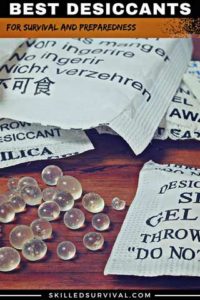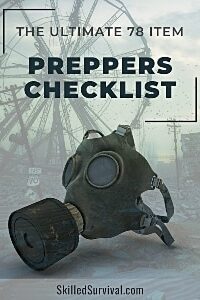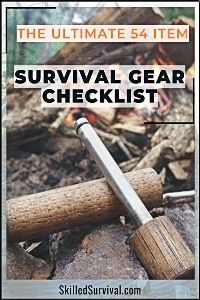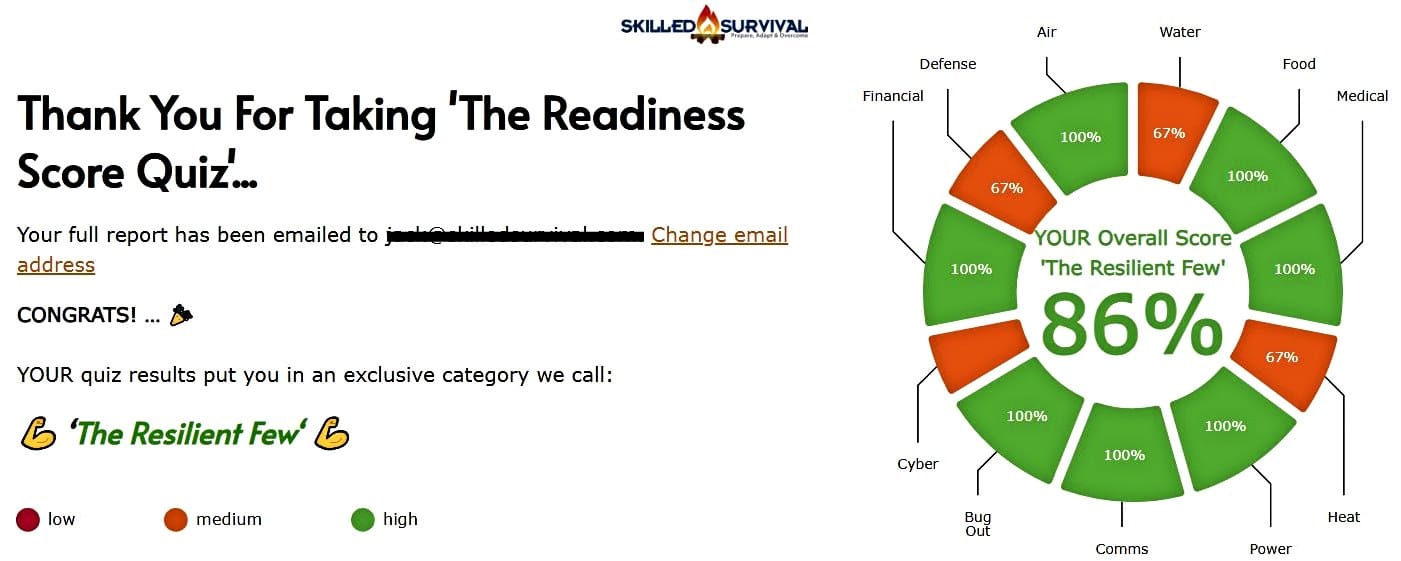
Desiccants are the unsung heroes of prepping—tiny moisture-fighting ninjas that protect your food, gear, and supplies from the damaging effects of excess moisture.
You don’t want your stuff getting rusty, moldy, or soggy, right? That’s where desiccants come in. They’re the prepper’s secret weapon for keeping everything dry and fresh.
Whether it’s food, electronics, or clothing, desiccants absorb moisture, preventing damage. So, let’s dive into why these little packets are a must-have in your prepping stash.
What Is A Desiccant Anyway?
The word desiccant is derived from the word “Desiccate.” Which found in the dictionary, is technically:
- To dry thoroughly, dry up.
- To preserve (food) by removing moisture, dehydrate.
So a desiccant is any material that absorbs moisture and retains it. It’s a chemical you place inside an enclosed space or container.
If it’s 100% sealed, a desiccant will attract and trap excess moisture within.
Desiccants are most often found in packaged foods. But they’re also ideal for keeping moisture sensitive electronics, tools, and weapons rust-free. Because humidity is one of the primary drivers of corrosion and spoilage. Desiccants are made to combat this.
A prime example is to maintain the freshness of foods. Especially ones that quickly spoil. So if you spent money, time, and energy dehydrating (or freeze-drying food), desiccants protect it.
They prevent the dried foods from rehydrating and spoiling your supplies.
↓ What Is A Desiccant?
What Happens If You Accidently Eat Them?
Desiccants are mostly safe to handle; however, they can be harmful in certain situations:
↓ What Happens When You eat Desiccant?
Not For Consumption
We’ve all seen those silica gel packs in a box of shoes. And we’ve chuckled at the silly “Do Not Eat” warning plastered on it.
Seriously? They don’t look or smell at all appetizing. So I’ve always wondered, “why the stern warning”? But it turns out there’s a reason to avoid consuming desiccants.
They’re, by design, good at absorbing and holding water. They can even pull water directly through your skin. In particular, you should keep them away from your eyes, nose, and mouth.
Powerful desiccants damage sensitive skin and tissue.
Have you ever mixed concrete and noticed a sharp stinging sensation in your nose? That’s concrete dust you inhaled. The lime in the cement pulls water out of your nasal passages.
You’ll also notice your hands are dry and chapped if touch it without gloves. Again, the desiccant has sucked the water from your skin. So what happens if you eat one?
Enough could form a large solid mass INSIDE your stomach that needs to be removed by surgery! But that would take a TON of it. In most cases, it’s more of a choking hazard.
SO KEEP THEM OUT OF REACH OF CHILDREN.
↓ What Happens If You Eat A Silica Gel Packet That Says, “Do Not Eat” ↓
So when working with a powerful desiccant, always protect your eyes, nose, and mouth. It’s also smart to wear gloves and protective clothing on exposed skin. And for those small silica gel packs “Do Not Eat Them.”
Note: While those “do not eat” warnings might seem silly, the bigger fear is that a baby or pet would accidentally consume them.
Babies put everything in their mouths. And dogs love anything that smells like beef jerky. So those warnings are to let YOU know to keep them away from those who might accidentally consume them.
Keep Away From Pets
Keep all desiccants away from your pets.
Most pets avoid the stinging sensation of an airborne desiccant, like concrete dust. But don’t take chances. Keep your pets away.
Some weaker desiccants (dry rice, flour, etc.) are food items that might entice your pets. Keep them stored out of their reach, and you’ll both be happier.
Trust me: Pet surgery is very expensive nowadays.
Cobalt Chloride
Another safety concern comes from the color-change indicators desiccants. These have Cobalt (ii) Chloride in them. When dry, this material is light blue. But slowly changes to a bright pink after absorbing water.
These blue/pink indicator silica gels are common in the US. They are also available in sporting goods and craft stores. But, there’s a concern that cobalt (ii) chloride is hazardous.
The European Chemicals Agency suspects it’s carcinogenic. But test results aren’t conclusive yet… So it carries a label of “substance of high concern.”
I recommend avoiding the blue/pink indicator silica gels. At the very least, it adds one more argument NOT to snack the silica packets in your new shoes! Here’s an article from the National Park Service.
It includes more information on cobalt (ii) chloride in silica gel.

Want a free 78 item preppers checklist?
Enter your email below to instantly download this Complete Checklist PDF. No purchase necessary. 👇 👇Why You Should Invest In Desiccants & Silica Gel
To prepare, we invest in quality survival tools and supplies.
We do this to protect ourselves and our families from an unknowable future. But many of these tools and supplies will sit around for years before they’re used. And honestly, we all should pray we never need to use these survival supplies, right?
No one in their right mind hopes for a real disaster! But you still must ensure your supplies are in the best condition possible.
You don’t want your emergency supplies investment to spoil, rust, or decay. The best way to protect these supplies is to keep them away from water, moisture, and humidity.
That’s why desiccant packs and silica gel are so great.
↓ 8 Ways to Use Silica Gel Packets
Protecting Your Survival Gear & Supplies
One of the first questions people ask me about desiccants is,
“Exactly which survival supplies should they protect?”
Upon review of my survival gear, I realized EVERYTHING is susceptible to moisture damage!

Want a free 54 item survival gear checklist?
Enter your email below to instantly download this Complete Checklist PDF. No purchase necessary. 👇 👇There are the obvious supplies (food storage, gun safes, ammo storage, buried survival caches). But these are not the only items that benefit from a low-humidity environment.
I also keep desiccant containers in my tool chest. This keeps my power and survival tools rust-free and sharp (like all my expensive survival knives).
I keep my garden seeds in a sealed container with several small desiccant packs. These packs prevent the seeds from sprouting prematurely and eliminate mold growth.
During the winter, I keep a survival blanket and spare clothes for car emergencies in a giant zip lock bag. I add a large capacity desiccant to prevent them from feeling damp. I also add desiccants to my bug-out bag, get-home bag, and ammo cans as well.
Just about any survival tools must be kept as clean and dry as possible. And that’s why desiccants are a critical survival tool in and of themselves.
They help protect your important survival supplies for the long haul.
↓ 10 Surprising Uses Of Silica Gel You Didn’t Know
Different Types Of Desiccants
There’s a broad range of desiccant options on the market. Remember:
A desiccant is any material that acts as a moisture absorber. And many materials can do this.
- Some are good at removing moisture from large spaces.
- Others are best for small enclosures.
The fundamental materials in each type are different. So let’s cover the most common types:
Silica Gel
Silica Gel is a stable polymer made from silicon dioxide (usually in the form of small beads). They can adsorb roughly 10-20% of its weight in water vapor.
Silica gel is chemically inert and is considered to be non-toxic. You can find small silica gel packets in medication bottles, food pouches, and even shoe boxes.
This past weekend, I opened a bag of beef jerky. I discovered the familiar white silica gel packets keeping my favorite snack dry.
One interesting fact about silica gel beads is: They don’t feel damp or lose shape even after they’re fully saturated. Most small disposable silica gel packets are for single use only. But, some large silica gel containers are reusable.
These reusable ones often include a moisture absorber indicator. One that changes color once the silica gel beads are saturated.
Since they can be reused, they can be “recharged.” This is done by drying them in a low-temperature oven. Once cool, you can reuse them!
↓ How Does Silica Gel Work?
Calcium Chloride
Reusable silica gel packets are not your best option when removing A LOT of moisture from a larger area. Large humid spaces are where calcium chloride desiccants are most useful!
Calcium chloride is a fancy name for salt and is generally found in bags of small white pellets.
Calcium chloride is not a reusable desiccant, unlike silica gel. Most calcium chloride desiccant setups are simple. They’re basically a small basket of pellets held in a mesh basket over a bucket.
As the calcium chloride adsorbs water, it slowly dissolves and drips down into the bucket. Eventually, leaving a bucket full of water and an empty basket.
These require more hands-on attention. Meaning you’ll need to periodically empty the bucket and refill the basket with fresh calcium chloride. But the results are impressive.
I’ve seen calcium chloride used in electronic cabinets the size of a small bedroom on ships. Making calcium chloride a good option as a larger-capacity moisture absorber.
Dry Uncooked Rice
In the modern world, we’ve all heard horror stories of dropping a smartphone in the kitchen sink or toilet. Common knowledge is to leave it turned off and stick it in a bag of rice for a couple of days.
Once it’s dry, you should be able to turn it back on without shorting out anything. The reason this works is that dry rice is a natural desiccant.
A small, enclosed area like a plastic bag can absorb the trace amount of water inside your electronics. It will slowly dry without having to open up the phone case.
Of course, it’s still nowhere near the efficiency of other desiccants, but rice is easy to find and cheap. Plus, it’s an excellent long-term food for survival caches.
I love any survival tool or supply that can pull double duty!
Non-Dairy Coffee Creamer
It turns out that non-dairy coffee creamer packets contain a surprisingly good desiccant. One of the creamer ingredients adsorbs moisture from the air. So you can build yourself a makeshift desiccant from a bunch of creamer powder!
No, not my first choice for a desiccant (especially with valuables), but it’s good to know it works in a pinch.
Cement Mix
Another desiccant to file under “it works, but now what?”
Cement mix is a powerful moisture-absorbing desiccant.
The nature of cement attracts moisture and converts it into a solid mineral. Don’t believe me? Try leaving a couple of bags of ready-mix concrete out in the rain. You’ll soon notice they suck in moisture and turn the bag into a hard concrete pillow.
This can even happen in a humid climate without direct contact with water. Of course, turning the powdery concrete mix into rocks isn’t the best way to control moisture. But it may be worth trying if you have a bag of concrete on hand and need a desiccant in a pinch.
Newspaper
Yes, you can use your stash of old newspapers for more than just starting fires.
Whenever I have wet boots or gloves that can’t go into a clothes dryer, I crumple up some newspaper and stuff it inside. Then I leave the paper-stuffed boots overnight in a warm place. Dry newsprint paper is particularly good at absorbing water.
So it draws moisture out of the fabric and holds onto it. Try swapping out the newspaper a couple of times a day to help dry your boots even faster.
Drywall
This idea was contributed by a Skilled Survival reader (Illini Warrior)
Drywall can also be used as a makeshift desiccant.
Best Silica Gel For Survival And Preparedness
The “best” type of desiccant depends on the intended use.
The desiccant you use to keep your basement, attached garage, portable garage, shed, or gear cache dry will not be the same you toss in your gun safe, ammo storage containers, or toolbox. And when it comes to keeping food safe, the requirements change again.
Calcium chloride is the most effective option for a large space like a basement, garage, or cabin.
But they're consumable products, so reuse is not an option. The good news is active ingredients are available relatively cheaply in bulk.
I would start with all purpose-built systems like Dri-Z-Air.
Dri-Z-Air is an all-in-one solution, and you can refill it with fresh calcium chloride pellets.
↓ Rv Dri Z Air Eliminates Moisture
If you go through a lot of calcium chloride (say, winter in the pacific northwest), you’ll need to buy in bulk.

Morton Safe-T-Power is one available brand consisting of nearly pure calcium chloride.
It can be used in the same “basket and bucket” systems as Dri-Z-Air, which makes it an excellent refill material. Calcium chloride systems are often too large and messy for smaller, more enclosed spaces (such as a gun safe).
The area is too small for all the white dust and buckets of water. In these situations, I turn to silica gel with a moisture indicator.
Hydrosorbants are reusable silica gel pack containers.
You can use them with your survival tools, a gun safe, a document safe, great for your gold or silver storage, or even with your food storage containers.
They include a window to see the moisture indicator This one contains the orange moisture indicator rather than the blue/pink one. It’s slightly more expensive but doesn’t have the same hazardous cobalt (ii) chloride.
Once the silica gel changes color, it’s time to toss the containers into a low-temperature oven. Just leave the desiccants for several hours to drive off the moisture and recharge them.
↓ Pelican Indicating Desiccant Silica Gel Canister Review
On a smaller scale, jars of dried fruits or jerky packages need desiccant protection. For these small containers, I turn to individual silica gel packets.
You can buy these in bulk and create small packets with fabric or coffee filters. The commercial 1g and 5g sizes are widely available and inexpensive.
They don’t have a moisture indicator added to the silica gel. But this means fewer chemicals stored with your food, so it’s not a significant inconvenience.
Whenever I open a bulk container of dried food, I toss in a packet or two. Doing this prevents outside moisture from creeping in and spoiling the remaining supply.
Similarly, when we jar a batch of dried fruit, I store it in glass jars with a silica gel packet. The desiccant keeps our dehydrated fruit from adsorbing extra humidity during our wet winters.
DIY Desiccant Packs – Saving A Few $$s
For those who like to Do It Yourself and save a few dollars, you can create desiccant containers from a few cheap materials. This idea came from a skilled survival reader (Illini Warrior) –
Fresh Step brand Crystals cat litter is 100% silica gel. For packaging, I wrap a handful in a commercial size coffee filter … for the money you get hundreds of desiccant packs …
↓ How to Make your own Silica Desiccant Packets for pennies!
Difference Between Oxygen Absorbers And Desiccants
Ok, so if you’ve read this far into this article, you already know how desiccants work. So let’s briefly talk about oxygen absorbers.
Oxygen absorbers are tiny packs that contain three ingredients:
- Iron filings
- Salt
- Clay
The clay material acts as a moisture absorber and helps the salt activate the iron filings. This activation process begins once the oxygen absorber is exposed to oxygen. The iron filings start oxidizing.
This is essentially the same process of creating rust on the iron filings. But rust is a byproduct; the important fact is this process releases nitrogen.
Adding nitrogen to sealed food packs helps keep them fresh for longer periods. This chemical reaction also removes oxygen from the package.
Nasty bugs and insects (such as weevils) cannot survive without oxygen. Most oxygen absorbers have a small pinkish pill.
This pill changes to blue once the oxygen absorber is no longer effective. Some more interesting oxygen absorber facts:
- Do not use oxygen absorbers with salt or sugar. If you do, you’ll end with a rock-hard block.
- Only store unused oxygen absorbers in airtight glass jars or Mylar bags. This prevents them from being prematurely activated by turning the surrounding oxygen into the air.
- You should try calculating the number of oxygen absorbers you need for the specific application. Use too many, and you’re unnecessarily wasting money. Use too few, and the food you’re trying to protect won’t be fully protected.
- You cannot reuse oxygen absorbers; they are a one-and-done device. Because the chemical reaction only works in one direction.
↓ Moisture Absorbers vs. Oxygen Absorbers
Can you use oxygen absorbers and silica gel desiccants together?
The answer is yes, but… The desiccant bags must not be close to the oxygen absorbers.
Desiccants will negatively affect the performance of the oxygen absorber when stored close by. Oxygen absorbers need moisture to function.
So if a silica gel desiccant is located close to the oxygen absorber, it will act as a moisture absorber and stop its activation process. Thus, turning the oxygen absorber into a useless device.
Final Thoughts
You’ve put a lot of time, money, and thought into which items are critical—survival resources and supplies to keep yourself (and your family) safe and secure.
Keeping those items clean, organized, and free from damage is a crucial part of your survival plan. No matter your survival plan, take time to ensure your food, weapons, and tools are at their best when you need them.
Desiccants are cheap insurance against moisture damage. Using them to protect your supplies is a necessary investment.
We’ve shown you a few good options for different scenarios. There are plenty of ways to adapt desiccants to your preparations!

Prepare, Adapt & Overcome,
P.s. - I just found out 2 out of 3 Americans don’t feel prepared for a 3 day disaster!!!
I guess this goes to show how modern society continues to embrace ‘living a fragile life.’ What’s crazy is… it’s so easy to fix.
To make sure YOU have the basics, watch our FREE training on “10 Simple Steps To Basic Preparedness” that shows you HOW.
Nothing crazy here… this isn’t doomsday prepping... just the basics every responsible adult should have before a disaster strikes.Why You Can Trust Skilled Survival...
Go here now to review a full breakdown of:
- Who We Are
- Our Credentials
- Our Mission
- & Product Recommendations...
Here are a few highlights of our teams credentials & certifications:
- Certified Member of a Mountain Search & Rescue Organization
- Plant Emergency & Safety Leader for a Major Food Manufacturer
- Member of the 10TH Mountain Division Hut Association
- Certifications: Avalanche 1, WFR, CPR
- Official Gear Tester for Numerous Outdoor Gear Companies
- Countless Multiday Backpacking trips into Remote Wilderness
- Bachelor's Degree In Mechanical Engineering
- Bachelor's Degree In Civil Engineering
- Bachelor's Degree In Biomedical Engineering
"It takes 20 years to build a reputation and five minutes to ruin it." - Warren Buffett
We're fully aware that trust is NOT something you GET but is EARNED.
And we'll continue to earn YOUR trust through our forthright and honest approach with each new Blog Post, Guide & Product we create...
P.s - I just took this FREE 60-second 'Readiness Score Quiz'👇
AND... I've still got a few gaps in my preps...🤔 But at least, I'm not part of 'The Fragile Masses'. 👍 Find out where YOU stand by answering a few questions...

Recommended Reading
Long Term Fuel Storage For Survival Emergencies
Long term fuel storage is crucial in emergencies, but fuels must be stored properly especially long term gasoline storage.
How To Store Seeds For Wise Prepping & Survival
When seed saving and seed storage, you must do it right. Learn how to store seeds so they'll thrive the next planting season.
Common Everyday Carry Mistakes YOU Must Avoid At All Costs
The only person qualified to build YOUR Best Everyday Carry (EDC) is YOU. To do it right, you must avoid these common mistakes and pitfalls.
Strategic Relocation: How To Find A Safe Pace To Live
Use strategic relocation to find a safe, defendable location to call home. Your choice of location WILL determine your survival fate.
Nuclear Fallout Map: Would I Survive A Nuclear Bomb?
Have you seen this nuclear fallout map? Or run a nuclear simulation to see the damage a nuke would do to your city? If not, check this out.
Homestead Survival: How To Master Plan Your Safe Haven
Use this simple 6 homestead survival plan to successfully survive (and thrive) even if the world falls into chaos...







![5 Gram [60 Packs] Food Grade Silica Gel Packs - Reusable](https://m.media-amazon.com/images/I/41vsBTbGC9L._SL500_.jpg)


